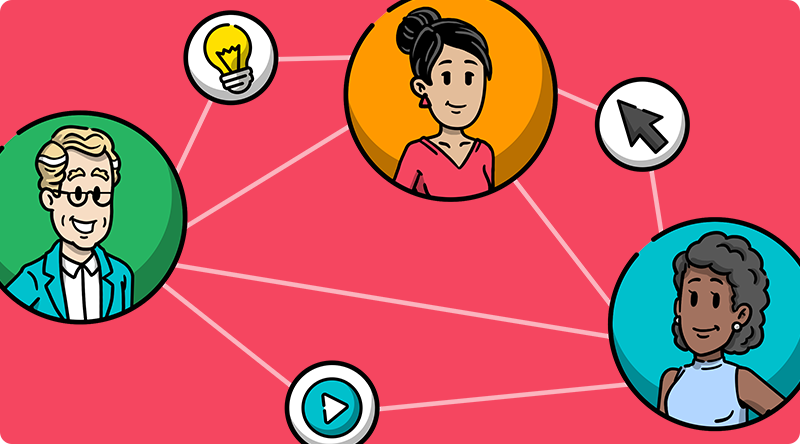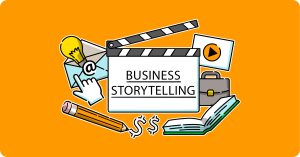How to use simplification, storytelling, and interactivity for engaging communication
Written by Tim Moss | 25th January 2024

Have you ever felt frustrated or misunderstood when trying to communicate with someone? Whether it’s your boss, customer, or colleague, business communication can be challenging. In fact, a study on effective communication by Grammarly found that miscommunication costs U.S. companies $12,506 per employee per year. So what are the top three challenges people face that make communication ineffective?
- People aren’t listening: Your audience is not paying attention or caring about what you say.
- People don’t relate: Your audience does not understand, trust, or feel what you say.
- People don’t retain the information: Your audience doesn’t remember, use, or share what you say.
How can you overcome these challenges and make your communications more engaging? In this blog post, you will learn three strategies that can help you capture, connect, and engage your audience: simplification, storytelling, and interactivity. These strategies can help you make your communications clear, relevant, and memorable. They can help you achieve your communication goals, whether communicating changes, selling products, or training employees.

1. Get your audience's attention with simplicity
It can be challenging to cut through the noise and grab people’s attention, especially when there’s so much information out there. The good news is that there’s a powerful strategy for making messages engaging: simplification.
Getting and keeping your audience’s attention requires a clear, concise, and relevant message. To achieve this, it’s important to use simple language and short sentences when communicating your main points. This not only avoids confusion but also ensures that your message is well-received and understood.
Simplicity can help you get your audience’s attention in several ways:
- It makes your message easier to understand and remember. People can only process and retain limited amount of information at a time. By simplifying your message, you help your audience focus on the most important information.
- It makes your message more appealing and persuasive. People like and more than complex ones. This increases the likelihood that they will take action, as you are not wasting their time with unnecessary or confusing information.
- It makes your message relevant and personal. People pay more attention to messages relevant to their needs, interests, and goals. By removing irrelevant or generic information, you show your audience you respect their time, and are only giving the information that is critical for them.
Pro tip: Consider using images and videos to simplify your messages. Visual aids can bring life to otherwise dull and lengthy text, breaking it up and making it more interesting. They can also help you explain even the most complicated concepts in a simple and memorable way. With simpleshow video maker, you can easily create engaging explainer videos with just a few clicks.
How can you simplify your message?
If you’re looking to simplify your message, here are some helpful tips to consider:
Use simple words that your audience understands. Avoid jargon, acronyms, and technical terms that may confuse them.
Use short sentences that are easy to read and understand. Using long and complex sentences will lose your audience’s attention.
Use bullets to highlight your main points and make them stand out. Avoid large blocks of text that may overwhelm your audience.
Use examples, analogies, or metaphors to explain your message and make it relatable. Avoid abstract or vague concepts that may leave your audience wondering.
Use questions, statements, or commands to guide your audience and keep them curious. Avoid passive or ambiguous language that may cause your audience to lose interest.
Example of Simplification
Let’s see an example of simplification in action. Here is an original message and a simplified message:
Original message:
Our company is undergoing a major transformation to become more agile, innovative, and customer-focused. We are implementing a new organizational structure, a new performance management system, and a new digital platform to support our strategic goals and enhance our competitive advantage.
Our company is undergoing a major transformation to become more agile, innovative, and customer-focused. We are implementing a new organizational structure, a new performance management system, and a new digital platform to support our strategic goals and enhance our competitive advantage.
Simplified message:
Our company is becoming more flexible and responsive. We’re making changes, and introducing a new structure, performance system, and digital platform. These updates will help us reach our goals and stay competitive.
Our company is becoming more flexible and responsive. We’re making changes, and introducing a new structure, performance system, and digital platform. These updates will help us reach our goals and stay competitive.
As you can see, the simplified message is easier to understand, remember, and act on. It also shows the benefits of the changes to the audience.

2. Connect with your audience's emotions through storytelling
Another communication challenge is getting your audience to connect with you. You may have a great and simple message, but if your audience does not trust you or feel invested, they may not care. That’s why creating empathy through storytelling is a powerful strategy for creating engaging communication.
The basics of storytelling
Storytelling is an effective way to communicate your message to your audience. It involves creating characters, plots, and conflicts to make your message more appealing and relatable. Through storytelling, you can communicate your values and beliefs and inspire your audience to join your cause.
Storytelling also involves explaining to your audience how your message is relevant to their lives, problems, and aspirations. You can use examples, analogies, or metaphors to make your message more meaningful and understandable.
The benefits of storytelling
Storytelling can help you connect with your audience’s emotions in many ways:
- It makes your message human and personal. People remember and trust stories more than facts and figures. Your story reveals who you are, what you care about, and why others should care.
- It makes your message compelling and memorable. Stories activate many areas of the brain, including those for emotion, sensation, and imagination. When you tell a story, you make your audience feel, see, and think, making your message vivid and memorable.
- It makes your message relevant and meaningful. Studies also show that stories can change people’s attitudes, beliefs, and behaviors. Storytelling allows you to show your audience how your message is relevant to their lives, obstacles, and goals and how it can benefit them.
Storytelling has the power to inspire, connect, and engage your audience. Whether your goal is to inform, persuade, or motivate, storytelling can help you achieve it and make a lasting impact on those you reach.
How to use storytelling?
To help you tell a good story, here are some tips:
To write a great story, use a clear structure with a beginning, middle, and end. Build up events and present a resolution. This creates an engaging story that satisfies your readers.
Use characters your audience can relate to. A good story has a protagonist your audience likes.
Use conflicts that your audience cares about. Impactful stories are those that present a relatable problem to their audience and offer a truly valuable solution.
Create emotions that inspire your audience. A good story has a mood your audience can feel and a message your audience can remember.
Pro tip: Storytelling doesn’t have to be hard. In fact, the Story Generator in simpleshow video maker can create a story for you with the power of AI. It combines simpleshow’s storytelling and scripting expertise with cutting-edge text-generating artificial intelligence technology to produce compelling, high-quality scripts every time. Users simply answer a few questions about their topic, and the AI technology instantly generates a video script that can be edited or turned into an animated video with the click of a button.

3. Engage your audience with interactivity
You have a great story to tell. But what happens next? How do you get your audience to take action? How do you get them to use what they have learned? You need interactivity!
What is interactivity?
Interactivity means adding engaging elements to a message that prompt the audience to act. When adding interactivity to a communication, it takes the audience from passive to active. In this context, interactivity includes the use of quizzes, drag-and-drop activities, or embedded links to create a dynamic and stimulating environment.
By adding these types of elements, the audience is able to interact with the content, experiment, learn, and discover on their own, helping them understand the subject matter better. Adding interactive elements not only supports learners in applying the information from the materials but also motivates them to explore additional resources on their own.
Why does interactivity work?
- Active learners remember more than passive learners. When you make your message interactive, you help your audience review what they have learned and check their progress.
- Research shows that there are many different learning styles. Some are fast, some are slow. Some do, some watch. When you make your message interactive, you let your audience choose how they learn.
- Interactivity helps your audience apply what they have learned. Research shows that learners need practice. They need to use the information they’ve received in real life. When you make your message interactive, you let your audience solve problems and achieve goals.
How do you make your message interactive?
Here are some tips for making your message interactive:
Include feedback mechanisms such as surveys, polls, and comment sections to encourage audience interaction. Responding to feedback encourages participation and connection, adds depth to your message, and allows you to tailor your content to your audience.
Implement a rewards system to incentivize engagement by offering virtual badges, certificates, or other recognition. Rewards create a sense of accomplishment and motivate participation in interactive elements. Gamify the experience by incorporating a scoring system or progress tracking.
Add interactive elements such as quizzes, puzzles, or drag-and-drop activities to engage and challenge your audience. Consider adding a leaderboard or recognizing the successful completion of challenges to add a competitive and engaging element.
Pro Tip: Transform your videos into an engaging and interactive experience with simpleshow’s AI-powered interactive video page. This revolutionary feature allows you to seamlessly add interactive elements to your videos, including a video summary, links to call-to-action or additional information, and customized quiz questions to gather opinions, test knowledge, or collect data. With the ability to check video performance analytics, you can gain valuable insights into page views, video views, and interactive quiz results.
4. Conclusion
Whether you’re managing change, promoting products, or training employees, you can harness the power of simplification, storytelling, and interactivity to create customized messages that leave a lasting impression.
With simpleshow video maker, you can create engaging explainer videos that will captivate your audience. The Story Generator feature lets you turn complex concepts into compelling narratives, while the Interactive Video Page lets you seamlessly add interactivity.
Do you want to learn more about engaging communication? Don’t miss our upcoming webinar:
“Capture, Connect, Engage: Three strategies to overcome your top communication challenges.”
Date: 15th of February 2024
Time: 12 p.m. EST
Date: 15th of February 2024
Time: 12 p.m. EST
Join our team of experts as they guide you in improving your communication skills and provide you with valuable insights to increase the impact of your messages.
Discover the art of capturing your audience’s attention and keeping them engaged with your message. Sign up now!
Discover the art of capturing your audience’s attention and keeping them engaged with your message. Sign up now!



